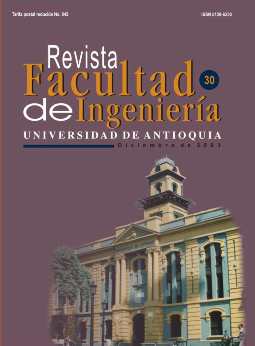Hidroxiapatita macroporosa obtenida en la Universidad de Antioquia: síntesis, caracterización y comparación con el hueso esponjoso y calcinado de bovino
DOI:
https://doi.org/10.17533/udea.redin.327318Palabras clave:
hidroxiapatita macroporosa, caracterización de materiales, biocerámico, implantes óseosResumen
Se obtuvieron bloques macroporosos de hidroxiapatita caracterizados por absorción atómica, difracción de rayos X, análisis por infrarrojo y microscopía electrónica SEM. Se realizó un diseño experimental al inducir la macroporosidad con tres agentes macroporosos naturales: montanoa quadrangularis, asparagus ofssicynali y zea mays. Se comparó el bloque macroporoso con el hueso calcinado y esponjoso de bovino y el que mejores resultados presentó fue uno elaborado con zea mays. El bloque presentó las siguientes características: du-reza en la escala de Mohs de 2,5-3,0; porosidad total por absorción de agua: 85% en volumen; porosidad por análisis de imagen: 18,61% en área; diámetro máximo de poro: 1.048 µm; módulo de ruptura: 6,35 kg/cm2; relación molar Ca/P: 1,65 y densidad: 3,11 g/cm3.
Descargas
Citas
Vallet, María. “Biocerámicas: Inertes y bioactivas”. En: Revista de la Real Academia de Ciencias Exactas, Físi-cas y Naturales. Vol. 90. No. 4. 1996. pp. 269-273.
Sinha, M. K. et al. “Porous Hydroxiapatite ceramic and its clinical applications”. En: Interceram. Vol. 49. No. 2. Alemania. 2000. pp. 102-105.
Korkusuz, Feza. et al. “Do porous calcium hydroxiapatite ceramics cause porosis in bone? A bone densitometry and biomechanical study on cortical bones of rabbits”. En: Biomaterials. Vol. 16. No. 7. 1995. pp. 537-543. DOI: https://doi.org/10.1016/0142-9612(95)91127-K
Arita, I. H. et al. “Chemistry and sintering behaviour of thin hydroxyapatite ceramics with controlled porosity”. En: Biomaterials. Vol. 16. No. 5. pp. 403-408. DOI: https://doi.org/10.1016/0142-9612(95)98858-B
Echavarría, Alejandro et al. “HAP sintética de porosidad inducida-Comparación con el hueso calcinado”. En: Revista Facultad de Ingeniería. No. 19. Medellín. 1999. pp. 56-64.
Klein, C. et al. “Osseous substance formation induced in porous calcium phosphate ceramics in soft tissues”. En: Biomaterials. Vol. 15. No. 1. 1994. pp. 31-34. DOI: https://doi.org/10.1016/0142-9612(94)90193-7
Engin, N. Ozgur. Manufacture of hidroxiapatita bioceramics. Tesis M. Sc. –Middle East Technical University-Ankara (Turkey). 1999. p. 9. http://www.mete.metu.edu.tr/RESEARCH/PROJECTS/CERAMIC/pubmacro.htm
Gómez, J. y Clemente, R. “Técnicas de precipitación como alternativa a la tecnología de recubrimientos con HAP mediante plasma spray”. En: Revista Latinoamericana de Metalurgia y Materiales. Vol. 20. No. 1. 2000. pp. 30-38.
Piñeda, H. et al. Eliminación de fluoruros utilizando hidroxiapatita. XXVI Congreso Interamericano de Ingeniería Sanitaria y Ambiental. Córdoba. 1998. 13 p.
González, Ramón. “Biomateriales: Una ciencia moderna que exige una adecuada educación y formación profesional”. En: Revista Cubana Investigaciones Biomédicas. 13 (1-2). 1994. pp. 26-36.
Martínez-González et al. La hidroxiapatita en el relleno de los defectos óseos. Julio, 1997. http://www.coem.org/revista/anterior/07-97/articulo.htm
Restrepo, Gloria. Síntesis, caracterización y pro-piedades fisicoquímicas de óxidos mixtos TiO2-SiO2 y ZrO2-SiO2, eventualmente dopados con Fe(III). Tesis Ph.D. –Universidad de Sevilla- Sevilla (España). 1999.
Rouquerol, J. et al. “Recomendations for the characte-rization of porous solids”. En: Pure & Apllied Chemistry. Vol. 66(8). 1994. DOI: https://doi.org/10.1351/pac199466081739
Mari, Eduardo. Los materiales cerámicos: Procesos cerámicos. Buenos Aires. Editorial Alsina. 1998. pp. 85-90.
González, R. C. y R. E. Woods. Tratamiento de imágenes. Delaware. Addison-Wesley Iberoamericana S.A., 1996. p. 773.
Shi, D. and G. Jiang. “Synthesis of hidroxyapatite films on porous Al2O3 substrate for hard tissue prosthetics”. En: Materials Science and Engineering and Building. 1998. Elsevier. p. 8. DOI: https://doi.org/10.1016/S0928-4931(98)00048-4
Rhee, S. H. “Synthesis of hydroxyapatite via mechanochemical treatmen”. En: Biomaterials. Vol. 23. 2002. DOI: https://doi.org/10.1016/S0142-9612(01)00229-0
Park, J. and R. Lakes. Biomaterials. An Introduction. Plenum Press, Nueva York. 1992. DOI: https://doi.org/10.1007/978-1-4757-2156-0
Descargas
Publicado
Cómo citar
Número
Sección
Licencia
Los artículos disponibles en la Revista Facultad de Ingeniería, Universidad de Antioquia están bajo la licencia Creative Commons Attribution BY-NC-SA 4.0.
Eres libre de:
Compartir — copiar y redistribuir el material en cualquier medio o formato
Adaptar : remezclar, transformar y construir sobre el material.
Bajo los siguientes términos:
Reconocimiento : debe otorgar el crédito correspondiente , proporcionar un enlace a la licencia e indicar si se realizaron cambios . Puede hacerlo de cualquier manera razonable, pero no de ninguna manera que sugiera que el licenciante lo respalda a usted o su uso.
No comercial : no puede utilizar el material con fines comerciales .
Compartir igual : si remezcla, transforma o construye a partir del material, debe distribuir sus contribuciones bajo la misma licencia que el original.
El material publicado por la revista puede ser distribuido, copiado y exhibido por terceros si se dan los respectivos créditos a la revista, sin ningún costo. No se puede obtener ningún beneficio comercial y las obras derivadas tienen que estar bajo los mismos términos de licencia que el trabajo original.










 Twitter
Twitter